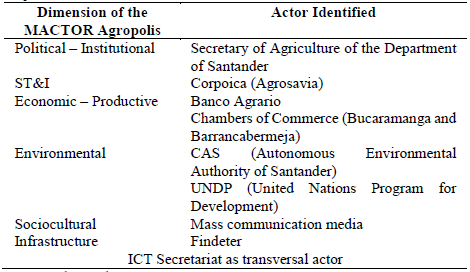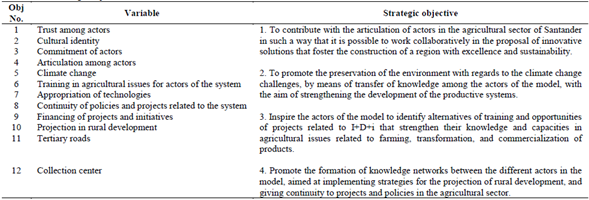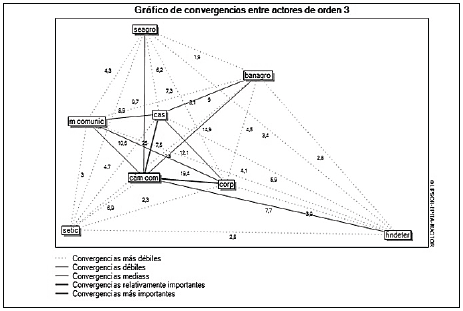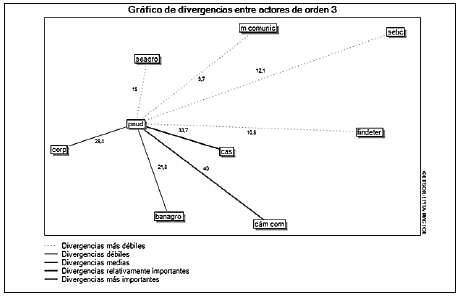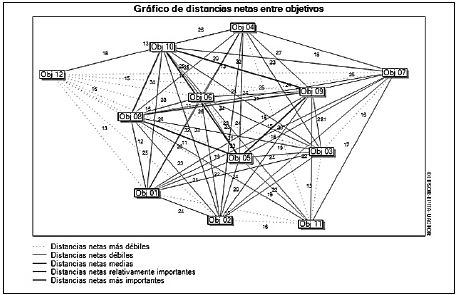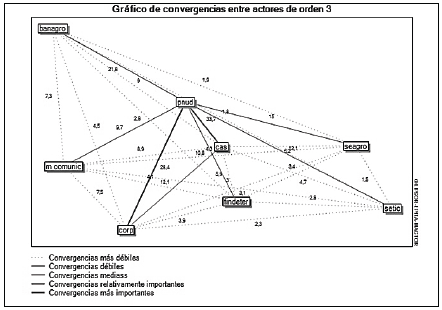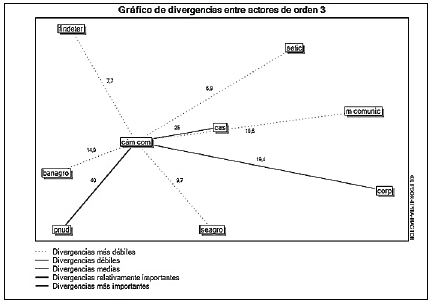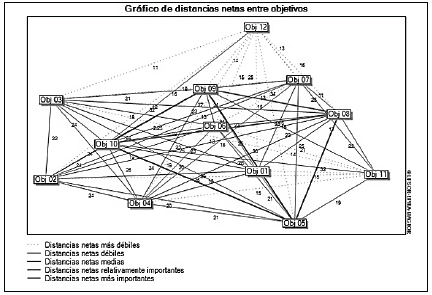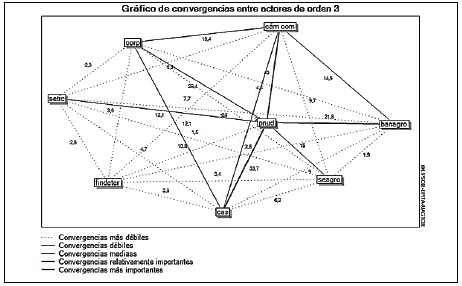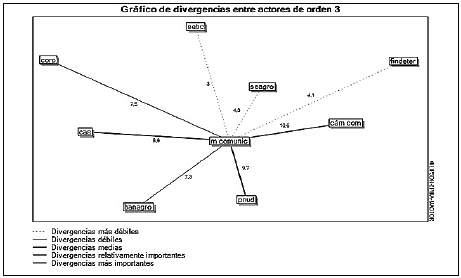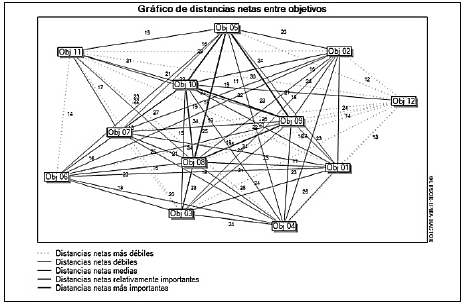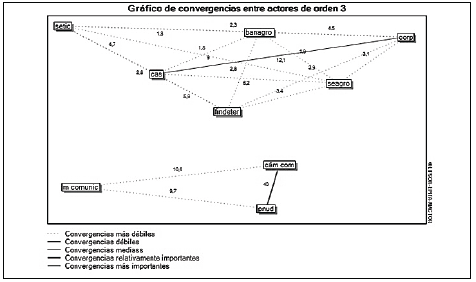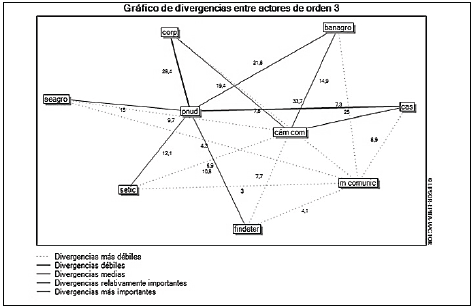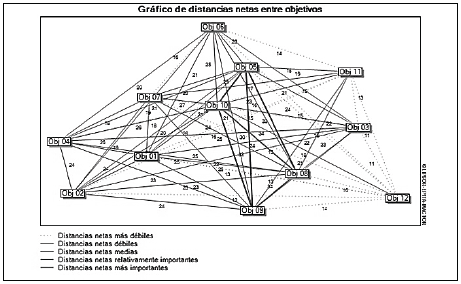1. Introduction
The planning structure of the department of Santander includes initiatives such as the Development Plan “Santander Unites Us 2016-2019, where the prospective exercise stated in the document “Santander Vision 2030” [1] is recognized as a fundamental contribution since it is based on the territorial prospective approach [2]. Territorial prospective is a powerful instrument to secure and promote development of the territories. Territorial prospective exercises are valuable contributions to develop the Colombian territory, to act appropriately in the face of globalization, to decentralization, to the world mega-trends, to the territorial impacts of economy in the social, cultural, technological, environmental, and political aspects [3]. Prospective is a discipline that has as purpose the future analysis, “time which we had not reached yet” [4]. On the other hand, prospective can be conceived as “a process of articulation and convergence of expectations, desires and interest, and the capacity of a society to construct that future that takes shape as a desirable vision (…), the success of a prospective exercise lies in the capacity to summon and capture the expectations and the interest of the social groups (public and private sectors, universities, and the civil society) [3]. The results presented in this paper have been obtained within the framework of the Project called “Design of a collaborative work model among actors of the agricultural sector for the development of the Agropolis of Santander - Middle Magdalena”, also known as MACTOR Agropolis, executed under the call for projects No. 745 of Colciencias, within the strategic thematic axis of peace consolidation.
From the concept on which the MACTOR Agropolis project is framed, which refers to a "System of integration and urban-rural territorial articulation that favors scenarios for the competitive development of the regions and the improvement of the quality of life of the population, through: (i) The productive, social and institutional transformation, (ii) The interaction of key actors, and, (iii) Strategies focused on the creation and transfer of new knowledge, technologies, capacities, infrastructure, plans of production, commercialization and distribution in the agro-industrial sector" [5], several works have been generated among which the identification of actors that are part of the innovation system related to the agricultural and agro-industrial sector of the Santanderean region, as well as their convergences and divergences.
Since the reality is changing, and the role and function of certain actors may be modified either by the presence of new actors, changes in the context, or simply because of changes in the actor itself [6], and according to some elements of the system such as the outcome of possible conflicts among actors, they are uncertain in the future thereof. It is necessary to formulate hypotheses about the evolution of trends and about said uncertain elements [7].
Thus, this document gives an account of the achievements in the study of potential scenarios in terms of the themes of collaborative work and articulation of the actors who are part of the research process in MACTOR Agropolis.
2. Methodology
MACTOR (Spanish acronym for Alliances and Conflicts Matrix: Tactics, Objectives and Recommendations) was developed in 1989 - 1990 by François Bourse and Michel Godet, the aim of which is to provide an actor with assistance in deciding how to implement its policy on alliances and conflicts [8]. MACTOR facilitates data processing to place each actor with regards to strategic objectives and assess the balance of power among them in order to detect dominant, liaison, and autonomous actors [10].
The stages to conduct the analysis of actors in accordance with the MACTOR methodology are as follows: [9]
Locate each actor´s projects and motivations, their constraints and means of action (construct the actors strategy chart).
Identify the strategic challenges and objectives associated.
Place each actor over each objective and locate convergences and divergences.
Make a hierarchy of objectives and identify possible tactics.
Evaluate the balance of power of the actors.
State key questions of future.
The methodology employed used three mayor stages, distributed in the following phases and activities:
2.1. Phase 1: Literature search
A narrative review of literature was made in this first stage by means of search engines and the Scopus database, considering the relationship to the topic, with the following purposes:
Identify actors in the frameworks of the agricultural sector in order to draft a preliminary list of those who are framed in the Santander - Middle Magdalena Agropolis.
Obtain information associated to social networks, partnerships, cooperation among different actors.
A total of 2077 documents was obtained from the Scopus database. It was proposed to read only the first quartile of the most quoted results, supported in the Pareto principle and making a small adjustment, since it has been taken as a basis not 20% but 25% of the amount of documents (first quartile), where the information most acknowledged by the scientific community is found, corresponding to the review of 519 results.
2.2. Phase 2: Identification of actors
Based on the results obtained from the literature found in phase 1, we proceeded to identify the actors that make up the innovation system on which MACTOR Agropolis is based. To carry out the identification of actors, we started with their concept: Actors, according to the definition given by [6], can be people, groups or organizations that have interest in a project or program. Similarly, the term is understood as that determined individual that comes to be considered as a social actor when he represents something for the society, embodies an idea, a claim, a project, a promise, a complaint; in this way, the concept also applies to a political group, a radio station, a group of students, the taxi drivers union because they all have something to defend (Cities For a Sustainable Future Bulletin # 16, 2001) quoted by [11]. Subsequently, the reason for the existence of each identified actor was sought, according to which its mission was contrasted with the mission of other Colombian actors, with the purpose of finding its corresponding Colombian counterpart, it was considered, that this last one had presence or reach in the territory that comprises the MACTOR Agropolis, that is, Santander (Medium Magdalena).
The relationship of the identified actors with the MACTOR Agropolis project was established, using the research dimensions exposed by [5]:
Dimension 1: Political - Institutional. Oriented towards the definition of a governance structure for the MACTOR Agropolis.
Dimension 2: Economic - Productive. It has as focus the economic strengthening of different activities that arise from the agricultural, agro-industrial, and commercial sectors, among others.
Dimension 3: Social - Cultural. It is focused to the generation of actions within the framework of the Agropolis system, which seek quality of life for its inhabitants as well as opportunities that give way to resilience generated as part of the processes of the Colombian post-conflict.
Dimension 4: Environmental. It seeks to foster the balance of the system that frames the MACTOR Agropolis with the environment.
Dimension 5: Infrastructure - Connectivity. Associated to issues of infrastructure development both on the logistic level (in different productive chains) and in that necessary to improve the quality of life of the people who are part of the region and its bordering zones.
Dimension 6: STI (Science, Technology and Innovation). This dimension is transversal to the previous ones and aims at identifying, strengthening and developing capacities associated with the agricultural sector, especially in the areas of human resource training, rural extension, and articulation of actors that are part of the system.
Of the general group of actors identified, and based on an analysis made with the team of researchers of the MACTOR Agropolis project, those presented in Table 1 (based on the dimensions of the project in question) were identified as relevant actors (in relation to the theme of collaborative work and its promotion in the region).
Finally, the characterization of actors was carried out based on the information obtained from official websites, news in different newspapers, social networks, and the performance reports of each actor. This in order to have available inputs for the realization of the evaluation of each actor in phase 3, where the issues associated with actors and their interests were analyzed in relation to the challenges or strategic objectives established from MACTOR Agropolis (around the theme of collaborative work).
2.3. Phase 3: Application of the MACTOR prospective method
Based on what is stated by [5] for the analysis process of the MACTOR method, variables and strategic objectives were used as shown in Table 2. They were identified in the gatherings conducted with the actors participating in the Roundtable of the Agro-industrial Innovation System of Santander (initiative generated between MACTOR Agropolis and different allies of the triple helix: university - enterprise - State), taking into account that this paper presents results associated to the identification and study of scenarios that support the outcomes of the Project in question. Similarly, the construction of the input matrices 2MAO (Second order Actors & Objectives Matrix) and the MID (Direct Influences Matrix) presented in Tables 3 and 4, were constructed in conjunction with the team of researchers who are part of the academic and governmental sectors and that belong to the MACTOR Agropolis project.
2.3.1. 2MAO Matrix
The construction of the 2MAO matrix was made using the scale below, which indicates the intensity of positioning and characterizes the degree of priority that the objective has for the actor:
4 essential for the existence of the actor,
3 essential for the fulfilment of the actor's mission,
2 essential for the success of the actor's projects,
1 essential for the operating processes of the actor,
0 if no incidence. (+) if its incidence is positive; (-) if its incidence is negative.
2.3.2. MID Matrix
On the other hand, the MID matrix assesses the balance of power of the actors, i.e., the capacity that an actor has in order to impose its priorities on the others. It reflects the degree of direct influence that an actor has over all the other actors. Its construction was made by means of using the following scale describing the direct influences among the actors:
4: Actor Ai can question the existence of actor Aj.
3: Actor Ai can question the missions of actor Aj.
2: Actor Ai can question the projects of actor Aj.
1: Actor Ai can question, in a limited way both in time and space, the operative processes (management, etc.) of actor Aj.
0: Actor Ai does not have means of action over actor Aj.
It can be seen in the MID matrix that UNDP is the most influential actor in the game, and one of the least submissive to the influence of other actors, followed by Findeter as the second most influential actor, although it is also one of the most dependent on the game, together with CAS, which is the third most influential actor. Both the media and the Chambers of Commerce occupy the same ranking, since they are in a medium power relationship in relation to the whole system.
2.3.3. MIDI Matrix
The Direct and Indirect Influences Matrix (MIDI) was obtained through the calculation made by the software MACTOR© version 5.1.2-2003/2004 from the input MID input matrix, as shown on Table 5.
The interest of this matrix is to provide a more complete vision of the power balance game, because it considers the indirect influences that one actor has on another, since an actor may limit the range of choice of a second actor acting on himself through a third actor [12]. For these reasons, the analysis will be carried out considering the indirect actions in order to be able to extract a more accurate and complete conclusion of the game of power relations. It is worth mentioning that the indirect influence that an actor has on itself is equal to the indirect influence it receives from itself. This influence is called actor feedback and is represented by the diagonal of the MIDI matrix [12]. It can be seen that UNDP is the most powerful actor in the game because of its greater influence and is the second with lesser degree of global dependence. The second position is occupied by the Media, which has important indirect pressure mechanisms and is the most independent actor in the system, and the Chambers of Commerce with an average global dependence in the fourth position.
2.3.4. 3MAO Matrix
The resulting 3MAO matrix of position assessed (with regards to competitiveness) describes the position of each actor with regards to each objective. That is, considering its position (opposite, neutral, favorable) on each objective, their objective hierarchy and the power balance of the actors [12], characterized by the Ri* coefficient, these three points allow the model to be adjusted to reality. The 3MAO matrix results from the following calculation (eq. (1)) made by the MACTOR software.
It is important to mention that the graphs of scenarios generated are obtained from the corresponding 3MAO matrix for each one, and that the matrix is generated from the modifications made in the assessment of actor-objective positions of the input 2MAO matrix. Therefore, the graphs obtained are of a third order. The ri* quotient characterizes the balance of power of the actors, where the strength relation of one actor considers its direct and indirect influences and dependences, as well as their retroaction. The quotient is calculated with the aid of Ii and Di, direct and indirect influence and dependence of the actor i and the Direct and Indirect Influences Matrix (MIDI) ij [12]:
Ri takes into account the margin of discretion (Ii - (MIDI) ii) of actor i; i.e., its net direct and indirect influence (Ii) minus its retroaction (MIDI) ii. The relative margin of discretion ((Ii - (MIDI) ii) / S) of the actor will then be deflected by the quotient (Ii / (Ii + Di) that allows to integrate the dependence (Di) of this actor. The Ri indicator is normalized in 1, therefore, if all the actors had the same relationship, all the ri quotients would be equal to 1. An actor that has a normalized balance of power greater than 1 has a relationship superior to the mean [12]. Normalization is given by its mean, defined as:
Therefore, the normalized Ri* quotient is the one shown below:
3. Results
Actors classified as "dominant or high power" were chosen for the scenario approach, because they have a high impact on the system, namely UNDP, the Chambers of Commerce and the Media, according to the MIDI matrix. The results were contrasted with regards to the mean (neutral) position of the actor, for this reason, its position was changed from favorable to opposite with regards to the fulfilment of the objectives, except for the neutral assessments, with the aim of knowing how it would affect the system of study, not having the support of the most powerful actors therein.
3.1. Scenario 1
Modifications were made in the position of UNDP. The convergences graph (Fig. 1) indicates a strong convergence between the Chambers of Commerce and CAS. The ICT Secretary is observed as the least convergent actor of the system, since it has the weakest convergences with all other actors. On the other hand, the divergences graph (Fig. 2) shows a strong opposition of interests between UNDP and the Chambers of Commerce.
Fig. 3 shows a strong convergence on the objectives number 8, 9, and 10 as the most important links. This is because they are the objectives with the lesser number of neutral positions, since all actors show some favorable position for their attainment.
3.2. Scenario 2
Modifications were made on the position of the Chambers of Commerce. Fig. 4 shows that CAS and Corpocoica remain as the actors whose convergences are strongest of the system, in this case together with UNDP. On the other hand, Fig. 5 shows the stability associated to the conflict existing between UNDP and the Chambers of Commerce due to the impact this link has on the system, since they belong to the same category of “dominant actors”, as opposed to the unfavorable CAS loop because they belong to the quadrant of “autonomous actors”. It may be stated from Fig. 6 that greater convergence continues to occur on objectives 5, 8, 9, and 10.
3.3. Scenario 3
Modifications were made in the position of communication media in this scenario.
The convergence between UNDP and the Chambers of Commerce stands out among the changes that are manifested; it is a link that in the other scenarios was shown to be divergent. Also, the possible alliances between UNDP, Corpoica and CAS are maintained.
Findeter and the Departmental Secretariats remain the least convergent actors in the system (Fig.7). It should be noted that not having the support of the media in the system would have significant repercussions, since it generates conflict with the other high-powered actors in the system, as does the CAS, which is an autonomous actor (Fig.8). With regards to the convergence of objectives, no significant change is highlighted, as the objectives mentioned above remain mostly convergent (Fig.9).
3.4. Scenario 4
In this fourth scenario, changes were made to the position of UNDP, the Chambers of Commerce and the Media. From Fig.10, it is important to note that the partnership between UNDP and the Chambers of Commerce is significantly strengthened, and is four times more important than the partnership they have with the Media.
Another fact to emphasize is that the convergence of UNDP and the Chambers of Commerce, with Banco Agrario, the CAS and Corpoica, becomes much more critical, and the change of position of both UNDP and the Chambers of Commerce, has a significant impact on the whole system, because the convergence of interests among the other actors is very weak, so it can be said that UNDP, the Chambers of Commerce, and the Media are globally in a more favorable power balance compared to all the other actors. Fig.11 suggests that the opposition of interests becomes more critical, since Corpoica and CAS would be affected by the UNDP, and to a lesser degree, discrepancy is generated with the Chambers of Commerce. Finally, the convergences of objectives 5, 8, 9, and 10 remain as the strongest in the whole system (Fig.12).
4. Discussion and analysis
The MIDI matrix resulting from this paper identifies the UNDP as one of the dominant actors in the study system. The United Nations have been present in Colombia for several decades through their agencies, funds, and programs, who as international organizations have supported Colombia through international cooperation in projects oriented to mitigate the causes and consequences of the armed conflict. Additionally, the UN leads one of the five trust funds created to support the stage of peace consolidation and implementation of the accords [13]. Thus, in the context of the end of armed conflict, UNDP has been particularly useful in mobilizing and coordinating external assistance to peace processes, and has become an important channel for international funding, a critical coordinator of donor efforts and an expanding agency [14].
Likewise, it should be mentioned that the consolidation of peace is a strategic axis of the MACTOR Agropolis; therefore, having the presence of UNDP is key in its future development because the Middle Magdalena region has been one of the most violent in Colombia due to the armed conflict [15-18]. Additionally, within the context of peace consolidation the mass media play a very important role since they are catalogued as one of the most dominant actors in the system. The way they present the information influences directly on the construction of attitudes from the citizens with regards to a process, as well as the support and social validation of the accords and consequences that whatever may be agreed upon may have on the political, economic, and social levels [19]. For this reason, they are called “the State´s fourth power”.
Hence, according to the graph of divergences between actors in scenario 3 of this study (Fig.8), it is pointed out that not having the support of the Media in the development of the projects that are being developed in the Santanderean region, such as MACTOR Agropolis, has a significant impact on the system, in terms of strengthening the channels of diffusion, both in the stages of involvement of actors to collaborative synergies, as well as in the presentation of results associated with the initiatives mentioned, besides, they are considered by the actors as vital in the management of information and at the same time they have a solid image in the Middle Magdalena region of Santander.
On the other hand, and in response to the demand for land tenure and extension needs of the different agricultural sectors, the role of the government and the private sector in consolidating public-private partnerships (PPPs) understood as "collaborative mechanisms in which public organizations and private entities share some resources, knowledge and risks, in order to achieve greater efficiency in the production and supply of products and services" [20] is important for the integration of small farmers into value chains. It is important to mention the role of the government, which as a key actor in financing (because agribusinesses are conceived as high-risk businesses by the private sector), in addition to providing the legal framework for the implementation of the alliance (i.e., its guidelines), so that it generates guidelines that guarantee the active participation of the stakeholders and the structure for consultation among them [21-24].The private sector, for its part, continues to be the "driving force behind innovation and investment, and to facilitate the linkage of small producers with competitive and sustainable business initiatives" [25].Bringing the public-private partnerships model to the region implies the participation of the Chambers of Commerce of Bucaramanga and Barrancabermeja, Banco Agrario and the Secretariat of Agriculture of the department, actors hat have been identified as strategic because of their means of action and the significance of their presence in regional plans and projects, besides the participation of farmers for the development of PPP since their importance lies on the fact that “this group of actors contributes with substantial amounts of food in the world” [25]. Small producers are attended in their majority by the public banking, where Banco Agrario de Colombia is the only player. In turn, the private or commercial banking is attending to medium and large producers [26]. This is evidence of their particular attention to small producers. For this reason, and because of its wide coverage in Colombia, Banco Agrario configures itself as a key actor in the consolidation of PPP with a focus on the Santanderean region.
On the other hand, the analysis derived from the net distances graphs of different scenarios stated (Figs. 3, 6, 9, and 12) showed that facing the challenges of climate change in agriculture is one of the most convergent objectives between the actors and it has the greater impact for the MACTOR Agropolis. According to [27], climate change is a collective action issue on the global scale, therefore the need to rely on international cooperation stands out, whose role pertains to the generation, dissemination, and transfer of knowledge and environmentally sustainable technologies. In this sense, having the UNDP as partner in regional impact projects on agricultural issues creates a competitive advantage on the economic, social, and environmental levels in the department. This is because its wide coverage around the world, since it is present in 177 countries and territories besides having multiple allies of diverse nature, adding to the fact that the UNDP is key in the climate change issue and has provided its support to more than 140 countries since 2008. [28].
5. Conclusions
From the analysis of the results obtained, it is evident that there is a need for action by the different regional actors around a problem that affects the stability of the region. Added to the above, a great opportunity for the development of the MACTOR Agropolis in Santander-Middle Magdalena is identified, since a high degree of alignment between the actors of the system is foreseen to work together in the construction of a future oriented to the sustainable development of the region. This is possible by means of the achievement of the objectives (factors analyzed) raised in this project. It should be noted that there are no changes in the links between and with low-powered actors, since there is no evidence of the formation of potential alliances between them, nor of any relevant divergences. However, this is not a situation that can be modified at present, since investment in national and international cooperation projects that impact on the common objectives of the actors can modify this situation by consolidating potential alliances in the future.
It is recommended to work jointly with the UNDP, leading the process of articulation of actors to the system under the role of dynamic agents for the shaping and development of encounter panels as articulating mechanism, or even to strengthen the existing ones, such as the Round Table of the Agro-industrial Innovation System of Santander (MIA, Spanish acronym), where experiences and knowledge is shared for the construction of collective ideas and common, long-term working agendas. It is recommended to join efforts in order to promote the preservation of the environment in view of the challenges posed by climate change (i) with Corpoica and the universities in the region to lead initiatives that enable the application of scientific research and new knowledge in the enhancement of agricultural practices, in such a way that they contribute to the consolidation of new agricultural models that are environmentally sustainable and the compliance with common objectives for the development of ST&I, and (ii) with the support of CAS to develop strategies for the formation of human resources oriented to train the technical personnel to support agricultural extension programs, contributing in this way to the generation of awareness in the rural population both about the use of renewable natural resources and the proposal of solutions that allow to tackle the challenges associated to climate change; (iii) with UNDP, to promote international cooperation around topics of sustainability, focused on the environment.
Given the role of Corpoica to develop and execute activities of research, technology, and transferring technological innovation processes to the agricultural sector, besides to provide support and manage the National Innovation System in Agriculture (SNIA, Spanish acronym) through the National Subsystem of Research and Technological Development for Agriculture, it is recommended to strengthen the current link resulting from the convergence of interests with the Chambers of Commerce, in order to cultivate a potential partnership to foster the creation of an Observation Body which incentives actors to use it and to contribute in the study and understanding of the current situation of the agricultural sector, the identification of trends and opportunities to materialize them in innovative agro-business or the strengthening of the already existing ones. To do this, it is important to have the support of the National Learning Service - SENA, since it promotes the SENA Rural Entrepreneurship Program which “seeks to promote the generation of income through the development of the capabilities and competences of the rural population by means of strengthening and counselling of productive initiatives oriented to self-consumption and entrepreneurship” [29]. In turn, the presence of universities, which have research programs and groups that support the areas of interest for the development of the Agropolis, constitutes a scientific and academic foundation for the consolidation of this strategy.













